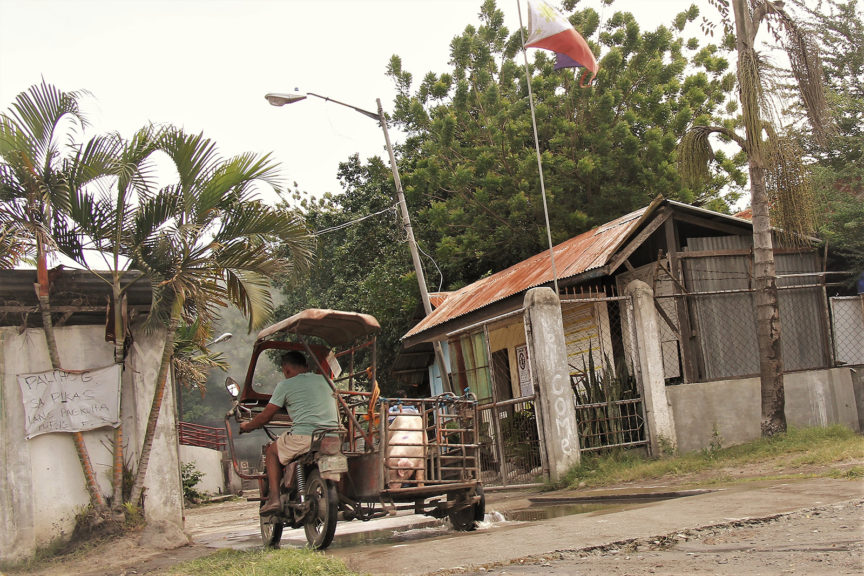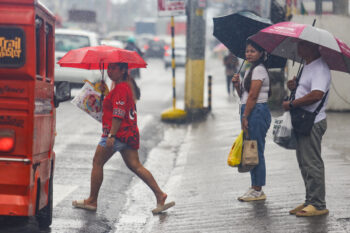 A tricycle carrying a pig enters the General Santos City Abattoir on Wednesday, 13 February 2020. Officials said they slaughter 80 heads daily, down from the 100 they used to butcher last month after they imposed stricter measures. MindaNews Photo by ROMMEL G REBOLLIDO
A tricycle carrying a pig enters the General Santos City Abattoir on Wednesday, 13 February 2020. Officials said they slaughter 80 heads daily, down from the 100 they used to butcher last month after they imposed stricter measures. MindaNews Photo by ROMMEL G REBOLLIDO
GENERAL SANTOS CITY (MindaNews / 13 February) – This city’s P8.4-billion swine and pork industry, the third largest in the country, could collapse if no measures would be undertaken to address problems caused by fears of the African Swine Fever (ASF), a business leader warned.
Elmer V. Catulpos, president of the General Santos City Chamber of Commerce and Industry Inc. said that while no single case of ASF in General Santos has yet been reported, swine producers are bracing for an emerging problem – Where to market their produce?
So far, the city remains free from ASF and veterinary officials, who vowed to protect at all cost the area from the virus, said they can only do so much in ensuring the safety and health of locally grown hogs.
The problem has prompted officials and business leaders to seek intervention from the national government.
This, as a veterinary official aired worries of swine producers of potential income losses due to a decline in market.
This city’s swine population is pegged at 457,000 heads with around 420,000 in large-scale commercial hog farms and the rest in backyard swine-raising.
The seemingly “panicky approach” by some local government units, not the ASF, is what may endanger the swine industry in General Santos, remarked city veterinarian Dr. Antonio Ephrem S. Marin.
Marin lamented what he called the seeming lack of a general policy to harmonize efforts by LGUs to confront the effects of the animal disease to business and economy.
He said General Santos remains free from the swine virus and they “will do everything to protect the city from ASF.”
The city supplies 25,000 to 30,000 swine heads monthly to as far as Luzon and the Visayas, taking land transport since sea vessels have stopped serving the General Santos route for years now.
But after some LGUs imposed lockdowns trucks carrying swine from General Santos were forced to find other routes, which means longer travel time.
This means more expense on vehicle fuel and maintenance, more food allowance for drivers and crew and feeds for the live animals, “all these eating up much on the income of farm owners,” Catulpos said.
Catulpos believed the issue must be addressed by a national policy that will coordinate and harmonize measures and cushion the impact of the ASF outbreak, “not only on animal health aspect, but to business and economy as well.”
Marin revealed that since the ASF outbreak in Davao Occidental, there has been a decline in the transport of swine from General Santos to their traditional markets, causing potential income losses for hog raisers.
Swine raisers complained that they could not sell since two weeks ago and that their hogs are now overweight and already beyond the ideal market size of 90 to 100 kilos, he said.
This could readily mean losses to the hog raisers, he pointed out.
“Swine that were supposed to be sold last month are now at 120 kilos and growing,” he said.
Should such situation continue, hog traders here raised fears of a possible imbalance in the supply and demand of swine and pork products when traditional markets in Visayas and Luzon start to feel a shortage in supply.
There are already reports of higher pork prices in some places where local hog raisers sell their produce and this may just be an offshoot of that emerging imbalance, Marin said.
“GenSan can supply ASF-free swine, only that we have to be allowed easy passage in areas where they have imposed lockdowns,” he said.
The official proposed that higher authorities declare the city as an “ASF-Protected Zone” and hogs being transported from here be given easy access to their markets after they are tested for and cleared of the disease.
On the other hand, Catulpos said government must look into opening a shipping route that will link this city to Manila and the Visayas to ferry livestock and their products.
In relation to this, Marin said there must also be a policy to protect livestock traders from the city considering they face the risk of falling victim to “predatory trading” in bringing live animals to far destinations.
In “predatory trading,” buyers can dictate prices that are disadvantageous to legitimate hog dealers who face potential losses because it would be more costly for them to bring back their animals.
As this developed, Marin clarified that General Santos is not on a lockdown, but imposes strict regulations like not allowing entry of hog or pork product shipments that lack necessary permits and health clearances.
Asked by a reporter if the present situation is bringing them headache, Marin retorted, “Hindi sakit sa ulo, masakit sa puso (It is not headache, it pains the heart). [Rommel Rebollido/MindaNews]
